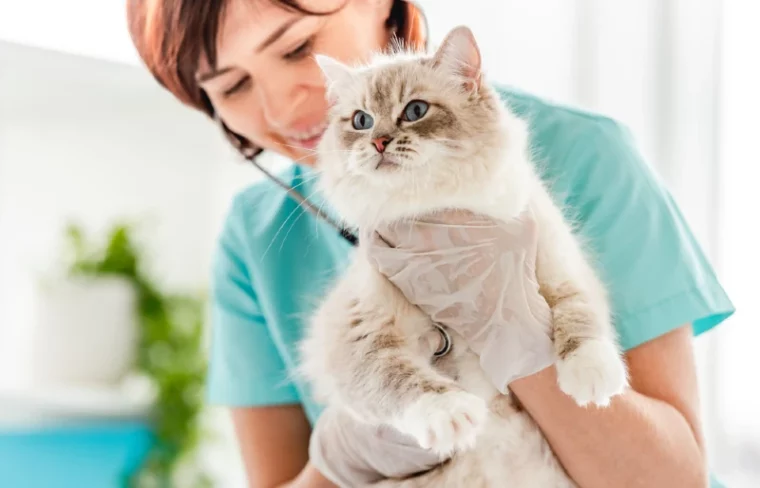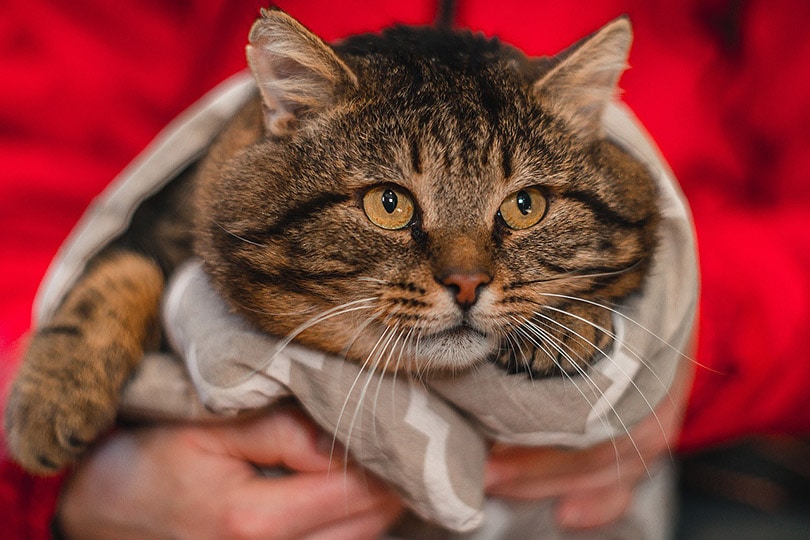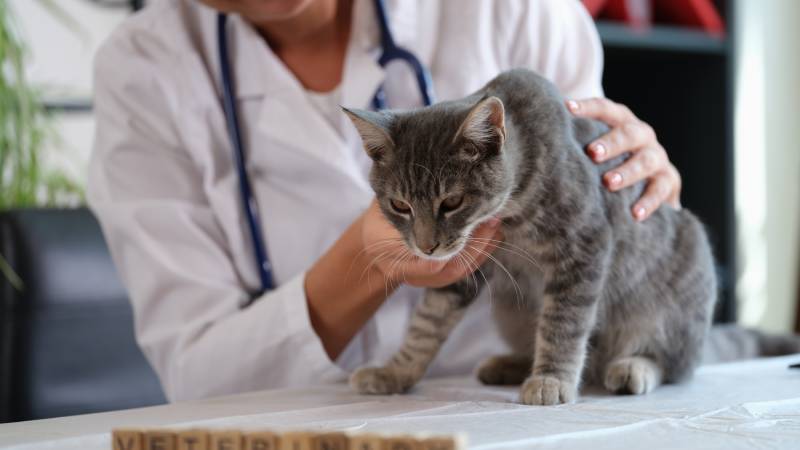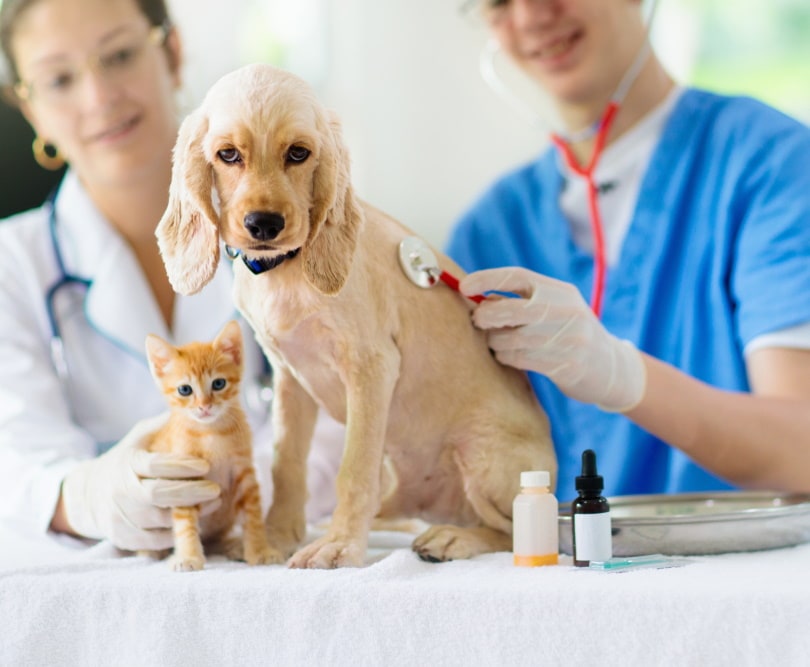
It’s never nice to hear that a cat has got parvo. It’s one of those viruses that you often hear about kittens catching, and it makes your heart sink because the prognosis generally isn’t great, and the investment at the vets is high. Unfortunately, cats are at risk of parvo regardless of their age, which is why getting them vaccinated against it is so important.
It’s easy for the virus to spread from one unvaccinated cat to another because it can be passed through urine, poop, and secretions—as well as through fleas—and stays active for months. The feline parvovirus cannot be spread to dogs. However, although dogs cannot spread feline parvovirus to cats, certain strains of canine parvovirus can be transferred to cats.

What Is Parvo in Cats?
Parvo is a highly contagious and severe illness that affects kittens and puppies and unvaccinated adult cats and dogs. However, the virus differs between cats and dogs as they don’t share the same infectious strain.
Parvovirus in cats is often referred to as feline infectious enteritis (FIE), feline distemper, or feline panleukopenia. The vaccinations that your kitten receives at a young age help fight against this disease, but regular booster shots are also required to keep your cat safe from infection.
Unfortunately, this virus affects the unborn kittens of an infected pregnant cat. The kittens may die in the womb due to the infection or may have long-lasting signs that will affect their balance and movement throughout their lives.
Scarily, parvo can survive in an environment for many months and even years. If one of your cats has parvo, you need to separate that cat from the other cats in your home as soon as you suspect the virus.
You’ll need to disinfect all the bedding, food and water bowls, and any other objects or materials your infected cat has been in contact with to protect your other cats from the virus. Many day-to-day disinfectants don’t kill parvovirus, so you’ll need to chat to your vet about which type to use.
Feline panleukopenia is so dangerous because it represses the cat’s white blood cells, disabling their immune system from being able to fight infection and resulting in a faster, easier, and wider spread of the virus throughout their bodies. The virus typically infects the cells in their bone marrow, intestines, and skin. With a weak immune system, your cat is at higher risk of catching other infections, too.

Signs of Parvo in Cats
Although the parvo strains differ between cats and dogs, the signs are similar and just as life-threatening. Below are the signs of parvo in cats:
Some parvo-infected cats may show no signs of the virus but die suddenly. Some may survive the illness without treatment. However, it is a slim chance. There is a much higher chance of your cat surviving feline parvo with immediate treatment from the vet.
When you take your cat to see the vet, they’ll test their blood and stool to accurately diagnose your cat with feline panleukopenia. They’ll then give them antibiotics, intravenous fluids, and other treatments your vet deems best to care for your cat until their health starts to improve. Sadly, there are no medications that will cure your cat of feline panleukopenia, but good care and treatment in the initial stages of infection will increase their chance of survival.
Remember to separate your cat from other cats in your home, even once they’re looking and acting healthier, as they can still transfer the virus for up to 6 weeks.

What’s the Difference Between Parvo in Dogs & Cats?
Although both cats and dogs can get parvo, cats are infected with the feline panleukopenia virus, while dogs are infected with canine parvovirus. Both viruses are closely related but are specific to their species.
While there is only one type of parvovirus in cats, there are two types of canine parvovirus, which are CPV-1 and CPV-2. CPV-2 commonly infects puppies and unvaccinated dogs and has a few variants—some of which can infect cats.
However, it is rare for cats to catch parvo from dogs. Regardless, if your cat has been exposed to a dog with canine parvovirus, it’d be safer to quarantine them for a few weeks or be examined by your vet to avoid the possibility of them spreading the virus to other cats in your home.
When a cat is infected with feline panleukopenia, their survival depends on the supportive care they receive from their vet, as there is no cure. The intravenous fluids are used to rehydrate your cat, putting fluids back into their body after they are lost through vomiting and diarrhea. Antibiotics are given to fight off any other infections that may attack your cat’s body due to their immune system being so weak from the virus.
When a dog is infected with CVP, they’re given treatment to boost their immune systems to help their bodies fight off the virus.

Similarities Between Feline Panleukopenia and CPV
Both feline panleukopenia and CPV are very contagious and can be spread in various ways, including direct contact, contact with infected stools, contaminated environments, and objects. The virus can even be transmitted from pet owners who have been in contact with an infected pet and haven’t washed their hands before touching another pet.
Both cats and dogs with parvo should be seen by a vet, hospitalized, and given treatment. They should still be isolated for a few weeks once they come back home as they both will still be contagious, even when they’re starting to look and act healthier and display fewer signs.
Both feline panleukopenia and CPV display similar signs, which could range from mild to severe, and both viruses have the potential to be fatal. In both cases, early vaccination against the two viruses is essential for prevention. Unvaccinated kittens and puppies, as well as unvaccinated adult dogs and cats, are at a much higher risk of infection and potential death.

Conclusion
The type of parvovirus that cats most commonly are infected with is feline panleukopenia. This parvovirus is different from the type dogs are infected with, which is referred to as canine parvovirus. However, unvaccinated dogs are vulnerable to different strains and variants, some of which are infectious to cats, although this is rare. To prevent your cats and dogs from being infected with parvo, vaccinate them against it from an early age and continue to give them booster shots when your pets are due for them.
Featured Image Credit: Tatyana Vyc, Shutterstock






